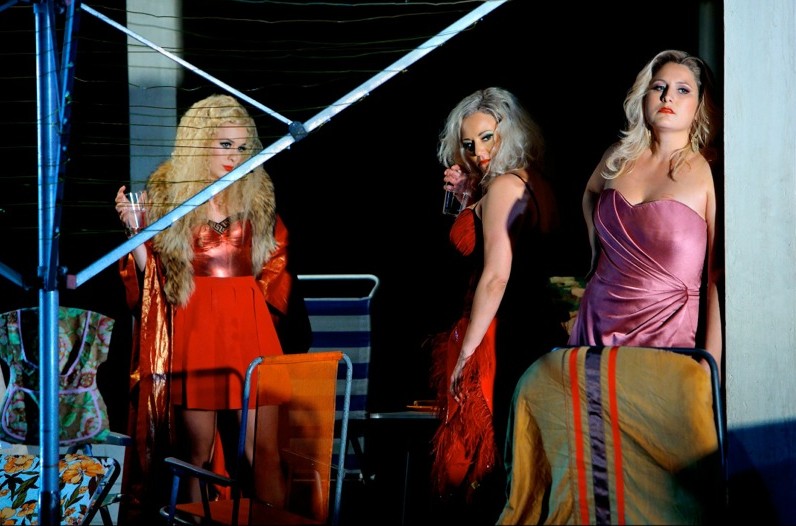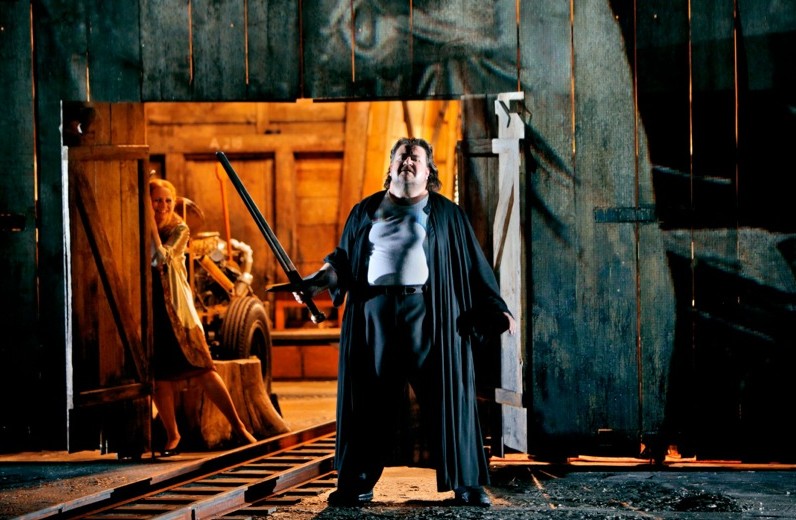Wagner’s Ring: Rheingold and Walküre, Bayreuth, August 2013 (original) (raw)
Posted on 16 August 2013
After the finest Rheingold I have ever heard, at the Proms with Daniel Barenboim and the Berlin Staatskapelle this summer, it would be churlish to draw comparisons with the Bayreuth orchestra under Kirill Petrenko. They played well, and there were some lovely moments, yet the production by Frank Castorf treated it as background music.
Rheinmaidens, all images ©Enrico Nawrath
Rheingold takes place at a sleazy motel on Route 66 in America. This is the highway linking Chicago to southern California, yet rather oddly the motel flies a Confederate flag. It’s a deliberate mish-mash, with 1950s gas pumps and car, along with 21st century wi-fi. Wotan is a seedy character, in bed with both Fricka and Freia. He does unmentionable things with a limp sausage, madly kisses Erda, and at one point in Walküre does the same with Brünnhilde as she squirms away.
Alberich, Loge, Wotan
Herr Castorf is a theatre director, and there is always a danger in bringing a theatre director’s mentality to bear on opera. The best opera direction fits action to music, but the liberal use of live video displays, sometimes focusing on individual singers sometimes on events entirely detached from Wagner’s opera, was an intrusion. Whenever stage-hands or performers unfurled a large sheet, you knew something was coming, and I came to dread it. In that wonderful Act I moment of Walküre where Siegmund bursts into Winterstürme we see a woman eating a cake covered with soft icing, at first with a spoon, then fingers, hands and finally her whole mouth. The same woman, whoever she is, drifts across stage in Act II. I don’t care what this imagery represents — it’s an intrusion.
Giants in Rheingold
I have written elsewhere about The Ring and the Eurozone crisis, comparing Sieglinde and Siegmund to East and West Germany. Sieglinde is married to Hunding, a man she doesn’t love, like East Germany being wedded to the Soviet Union, and in this production Hunding is made to look like Stalin, with film snippets of Soviet propaganda appearing. So I can’t complain. It’s a good idea. But there were too many ideas, and Rheingold in particular was far too busy.
Siegmund, Sieglinde, Hunding
The singing was something of a mixture too, but the Rheinmaidens in their cheap motel swimming pool were all good, with Mirella Hagen an outstanding Woglinde, and Martin Winkler’s seedy Alberich, with his bald head and bushy sideburns developed very strongly after a slightly uncertain start. Günther Groissböck and Sorin Coliban made convincing giants Fasolt and Fafner, and Nadine Weissmann was a fabulous Erda, whose brief appearance was the highlight of Rheingold.
After a weak first entrance, Norbert Ernst came through very well as Loge, easily outshining the Wotan of Wolfgang Koch, whose strongly sung Alberich was heard at Covent Garden last autumn. But there is a world of difference between the vocal demands on Alberich and Wotan, and Koch was presumably saving his voice for Walküre the following evening. There in Act II we heard the volume missing from Rheingold as well as precision of diction and pitch, but neither his body language nor vocal characterisation exuded the power and frustration it should. He sang and delivered but it was dull, and in the final scene with Brünnhilde his tired voice had lost pitch and focus. How different it was with Johan Botha who sang Siegmund with effortless superiority. He was partnered by Anja Kampe as a radiant Sieglinde, who produced a blood-curdling scream at the death of her brother, and opposed by Franz-Josef Selig who showed huge strength and clarity as Hunding.
The set for Walküre
As Brünnhilde, Catherine Foster delivered power, warmth and passion. This Nottingham born soprano is little known in England, having done much of her work in Germany, so it is surprising that her name was mis-spelled in the main programme for the Ring. Inattention to detail can be a killer in the opera world, and the huge plethora of unnecessary detail in this production betrays a lack of focus, if not confusion, on the part of director Frank Castorf.
Walküre is set in Azerbaijan, where oil exploration is booming, and the Wotan of Route 66 appears with a voluminous beard that he oddly removes for the final scene with Brünnhilde. Why? The nodding donkey oil pump in that scene was a distraction partly hiding him from view, and what was the point of the inert body of a man lying backwards in a pram in Act I? Costumes were eclectic. Claudia Mahnke’s Fricka in Walküre appeared in the sort of thing you hire for a fancy dress party on a Nile cruise. And the Walküren looked a mess and were of variable vocal quality. The huge revolving set, stretching from right to left and enormous heights at the top, provided ample space, both for Walküren and male oil workers, but it was all too distracting.
Botha as Siegmund
The audience, despite boos at the end of Rheingold, were otherwise surprisingly uncritical, but this was the second cycle, not the first. Good that it was so, otherwise I would have missed the stunning BBC Proms cycle under Barenboim’s direction. Yet even with the exigencies of this fussy production, a strong singer can rise above it and Johan Botha’s huge Wälse! was a moment to be savoured, despite the cake eating episode.
As tabloid newspapers well know, we are suckers for grisly news, yet I rather dread what this director will do with Siegfried and Götterdämmerung. Watch this space.
Categories
Tags
- Anja Kampe ,
- Bayreuth Festival ,
- Bayreuther Festspiele ,
- Catherine Foster ,
- Das Rheingold ,
- Die Walküre ,
- Frank Castorf ,
- Franz-Josef Selig ,
- Günther Groissböck ,
- Johan Botha ,
- Kirill Petrenko ,
- Martin Winkler ,
- Mirella Hagen ,
- Nadine Weissmann ,
- Norbert Ernst ,
- opera review ,
- review ,
- Sorin Coliban ,
- Wagner ,
- Wagner's Ring ,
- Wolfgang Koch





